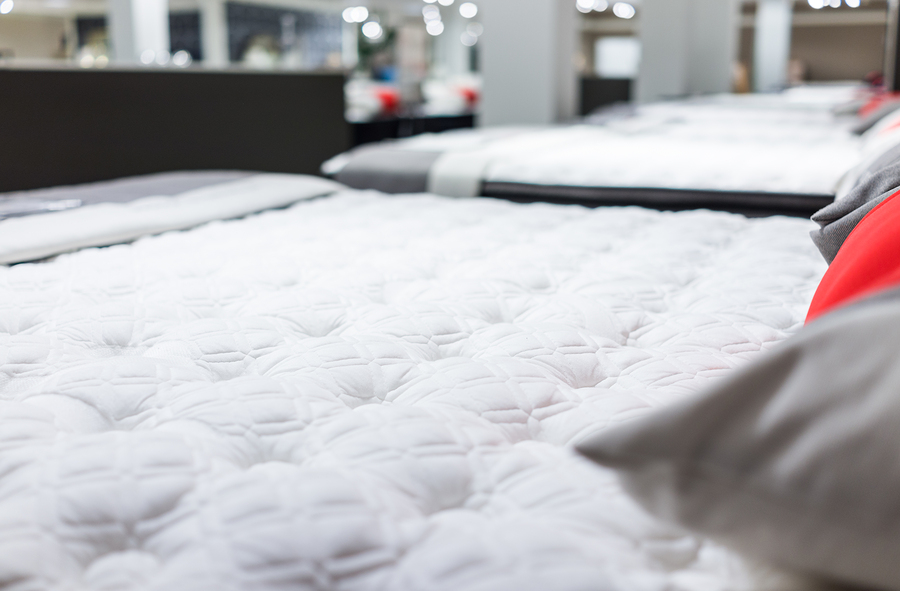Harnessing the power of humanizing differentiation
When we first started working for Serta® mattress brand, our wonderful client arranged for us to tour the mattress factory. We saw firsthand the great care taken to arrange the inner combinations of coils and surrounding layers of material to create the right balance of comfort and support when sleeping. They were proud of the efforts made to study spine alignment, blood circulation and how pressure points impact the quality of sleep.
Naturally, they wanted to highlight that understanding, material expertise and tech in marketing communication.
For our part, we also invested heavily in studying the purchase experience and shopping environment: the sleep products store where mattresses met the people who will ultimately spend a third of their lives atop their selections.
We were struck by the commoditized conditions at retail; an environment we referred to as the “Sea of White Rectangles.” Brands and models all looked the same, were presented in similar fashion with similar claims regarding what existed below the fancier furniture-like case fabric. Equally, we learned that consumers loathed the experience of bed shopping, and in some cases described it in used-car dealer metaphors.
Together with our client, we fashioned a new roadmap based on what happens on the other side of improved sleep. The emotional benefits and real-world lift related to getting more out of a good night’s rest. The impact that improved sleep has on creativity, work productivity, personal relationships, mental attitude and general happiness. Yes, sleep quality and sleep deprivation hits you in ways you may not even realize.
We worked to cast this in real human terms – real people stories – and how better sleep also improved your day, your happiness and your life. It wasn’t the nighttime rest imagery so typical in the bedding business – it was the next day’s improved experience that truly mattered.
Rather than the coils or support-giving design or temperature-regulating materials, Serta’s brand differentiation was elevated through the tangible, human outcome when sleep quality is markedly improved.
Commoditization can command the business – until disrupted
Sameness exists in so many product categories because we’ve come to a place where technologies and formulas are often very near parity. The real distance between one product and another in its category has been narrowed, slimmed down and parsed.
Pet foods are a great example of similar formulations, comparable language, packaging approaches, and claims around nutritional efficacy. The passion, love and relationship with pet parents and pets, and the desire to add value to the quality of their lives (mutually beneficial) is another matter entirely.
And others:
- Car designs and features within their utility, performance or luxury classes.
- Mobile phones and their screen tech, cameras and apps.
- Foods and their labels, ingredients and nutrition.
In virtually every product category you find, the capabilities and technologies are within close proximity to one another. But still companies fall in love with the efforts they make to install quality at every level, to source ingredients with great care, to craft solutions that deliver on taste or user experience. Yes, all of this matters, however, when looking to mine true differentiation…
Consideration must be given to humans, and their personal experiences with the product. It’s a vital part of the strategic discussion, often punted in favor of showcasing the latest tech wizardry. That’s great if you’re designing ads *for* the company’s engineers (but even they need a good night’s sleep). Each and every one of us is an emotional being who thinks with their heart first and mind second. As we’ve conveyed before: People are feeling creatures that think, not thinking creatures that feel.
Communication, brand, experience, shopping environment must be viewed through the lens of how people feel; and the changes that can occur in the quality of their lives when your brand gets the opportunity to be involved with them. It’s here where the entire brand proposition will be separated and elevated from everything else competing for share of mind, stomach or wallet.
Casper Casts a Different Story
Meanwhile back in the bedroom, sleep category disruptor Casper came along to reassess every aspect of bed marketing, including the retail sea of white rectangles retail paradigm, by-passing it entirely.
With an eye towards disrupting the current go-to-market model, Casper made changes in product design, e-commerce sales, extensive guarantees, and communication founded on lifestyle help over hype. Casper pushed community building and social conversation rather than the normal efforts to market “at” people.
Casper’s highly topical e-zine, VanWinkle, and investment in social channel engagement are examples of building relevance with their core customer base. They cultivated brand ambassadorship and harnessed incredibly powerful consumer reviews to influence purchase. Casper is humanizing the bed business, and in doing so, came out of left field to capture significant share.
At Emergent our approach to client businesses begins first with an effort to understand category conventions and behaviors. From there we work to enhance uniqueness and differentiation based on blending essential product truths with insight to consumer passions and interests.
Are you ready to take on the battle against sameness?
Looking for more food for thought? Subscribe to our blog.
Bob Wheatley is the CEO of Chicago-based Emergent, the healthy living agency. Emergent provides integrated brand strategy, communications and insight solutions to national food, beverage, home and lifestyle companies. Emergent’s unique and proprietary transformation and growth focus helps organizations navigate, engage and leverage consumers’ desire for higher quality, healthier product or service experiences that mirror their desire for higher quality lifestyles. For more information, contact [email protected] and follow on Twitter @BobWheatley.
